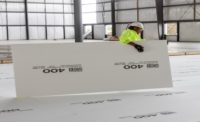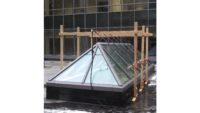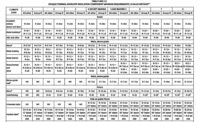He came to us with an idea and a business title, as big as his enthusiasm. A like-minded industry professional, tired of the same old fight about the same old subject; stucco leaks, William Cardot had an idea.
Cardot who's title is Building Envelope Specialist of the Tremco Sealants and Waterproofing Division, has been in the wall and ceiling industry for decades. Bill came to our Technical Services Information Bureau office in Orange, Calif., and wanted to talk to us about a testing facility that Tremco had built for the water testing of wall assemblies.
He explained that with the new energy codes calling for the use of continuous insulation as a compliance method to meet the new energy usage requirements for buildings, and specifically for stucco, there was no testing for water intrusion that had been done. Specifically he wondered how placing numerous penetrations through a foam sheathing and now hidden WRB, would still enable the cladding to mitigate moisture intrusion.
The reason he came to us is that approximately six to seven years ago, this magazine’s very own editorial director and our TSIB staff put together The Energy Code and Plaster Assemblies brochure. It was created as a “how to make continuous insulation work” document for the then new idea of using CI for compliance to the newly mandated energy codes. Of course the brochure states clearly to use EIFS first but if you wish to use stucco, it provided options with proven track records.
Talking Heads
So there in our office began the conversation about what was to be the first collaborations for water testing of stucco over foam. This collaboration was to include an array of industry experts including manufacturers, industry advisors, our TSIB, inspectors and engineers specializing in wall assembly performance, and some Tremco staff. No one entity more important than the other, each contributing an expertise for a given portion, all dedicated and curious.
Cardot laid it out: there were to be un-insulated assemblies with black paper and stucco netting only, and walls with paper and liquid applied WRB and even paper-backed stucco netting. The rest of the walls would have various configurations of the insulated assemblies shown in the brochure and one proprietary assembly. His suggested vision was to conduct water testing in two phases. He began, “Phase 1 will be to water-test the lathed walls and phase.” We immediately interrupted and asked why would one test a lathed-only assembly; it isn’t complete and besides what does that show?
Cardot was undeterred and continued with his vision. “And Phase 2 would be to water-test the completed assemblies with the stucco and finish.” He then laid out his idea to test the lath only assembly to see what happens because no test of this kind had ever been done. He wanted to see if a penetrated WRB would leak because once the foam was on, how would anyone know?
So there it was: A curious look at an age old tradition of placing a million holes in a concealed WRB. We again jumped, this time to the defense of the black paper WRB claiming that a water test would compromise the integrity of the Grade D paper during a wetting and drying process, which could affect the results of the phase two test thus casting further shadows on the belief that stucco leaks. So we agreed to have a “control” version that wouldn’t get wet. To say there was some back and forth would be an understatement, but in the end, we all landed in the same spot, “let do this” being that spot.
And so in early spring the adventure began. Cardot had his fellow employees build some walls to include a soffit configuration, some duct, pipe and electrical box penetrations and a window which is what ASTM E331 testing protocol requires. They had applied Tremco Dymonic 100 with ExoAir Duo and Quickflash products around some of the window openings and others just got the Grade D paper rolled into them. Then in early April, Steve Caldwell from Detect-it, myself, Jason Wigboldy from Rodenhouse and Cardot from Tremco showed up at its headquarters to lath the prepped walls. (To note and observe, Cardot had invited a young engineer from WJE named Karla Kruse whom was a pleasure to work with and had the arduous task of noting and reporting.)
Assembled Team
There began the first team: Caldwell, an ex-lather by trade; me, an ex-wannabe lather; Wigboldy, a fastener expert and jack-of-all trades, and; Cardot, the master organizer, when together, spent three days assembling some lathed walls under the watchful eye of Karla from WJE.
Caldwell and I missed a few studs when fastening the lath and were immediately called out by Miss watchful eyes who thought the holes should be sealed. I explained that if this were to indeed be a true test of actual conditions, then we should leave the missed fasteners in place. We all agreed to just leave it (them) and of course note the locations. In fact, on another part, Caldwell missed the stud right near the edge and pulled the fastener back out. This one she didn’t see and we both pinky swore to leave the hole and say nothing, after all we had reputations to protect. Wigboldy and Cardot in the meantime were cutting Z-furring and foam and staging them for installation on the CI walls.
Some weeks later, it was time for Phase 1 of the water tests, which meant spraying a lot of water on a lathed wall some with CI some with differing WRBs. For the soaking of the lathed walls test, the TSIB’s Bryan Stanley took my place to observe. The results were positive and as some of us might say, expected. There were no leaks through the WRB at the penetrations and fasteners or at the missed fasteners left in place (including our secret missed fastener-hole location). A couple of the walls did see some water intrusion but it was limited to the electrical box and duct penetration locations from improper sealing. I must point out that the test was without any pressure differential using the specified spray rack and was run for two hours.
Controlled Test Methods
During the summer months, the walls were scratched, browned and finished, then allowed to cure properly. Then it was time for the test of where water would be sprayed on the stuccoed walls for a two-hour period with a negative pressure created within the cavity to simulate wind driven rain. We had insisted that the walls be “complete,” in that they have a sheathed backside and did not put insulation in the cavity for two reasons:
We wouldn’t be able to readily see active leaks, and;
With CI on the exterior, you may not need to have cavity insulation to meet the thermal performance requirements.
So, we used Plexiglas in lieu of drywall as a sheathed backside component. For this phase there were many interested professionals in attendance, from manufacturers to engineers, inspectors to technical gurus.
I’m not going to try and sugarcoat it. The fact is, walls leaked. I am however going to clarify it.
On one stucco wall that was assembled with two layers of black paper and stucco netting (this was subject to the first stage water testing), a leak into the cavity was noted. Moisture was noticed at some penetration holes and at the sheathing board joint but after about a half hour, the leaks stopped, completely, everywhere. Through destructive testing the resulting stoppage was attributed to a simple occurrence we have always known. The black paper when wetted will wrinkle thus creating a path for water to run, which in this example, did.
The leak into the wall cavity that was the most significant turned out to be on the “control” wall with stucco netting over two layers of black paper (this one had not gone through stage one testing). The leak was sufficient to allow moisture to be observed on the backside of the double layer paper and puddling into the bottom track. During destructive testing it was found that the upper corners of the stucco stop butted together but had a big gap (I may have cut them crooked). Before application of the stucco an attempt was made to fill the gap with sealant.
Because the metal expanded at a different rate than the stucco and sealant couldn’t hold the edges together, the gap just opened up again allowing water to freely flow right in. Also, as was the common practice that I learned so many years ago, the casing beads are placed first then the black paper applied over the flanges, nesting at the angle. So at the top horizontal stucco stop flange, a reverse lap was created which allowed the water to get behind the black paper and run so freely. Had I placed the flange over the paper—even with the gap—we surmised there would have not been such a display of moisture intrusion.
An interesting note is that all of the CI walls performed way better with only one having a small occurrence from a junction box.
Then, to further re-enforce the industry claim that stucco doesn’t leak, the still wet stucco chunks cut out during destructive testing were viewed for absorption. The water had absorbed approximately 1/8 inch into the stucco that validates the claim made by the since passed industry expert Walt Pruter. He claimed that water will absorb into stucco at the rate of about 1/16 of an inch per hour under a steady flow of water across the surface. So, the claim of a total soaking of the stucco allowing water to find its way into the cavity through capillary action has been debunked.
Unfortunately, there isn’t enough space in my column to cover every aspect of this exciting industry collaboration. For a complete test result report you can go to wccinfo.org and look under the “Library” tab for a report from Intertek.







Report Abusive Comment